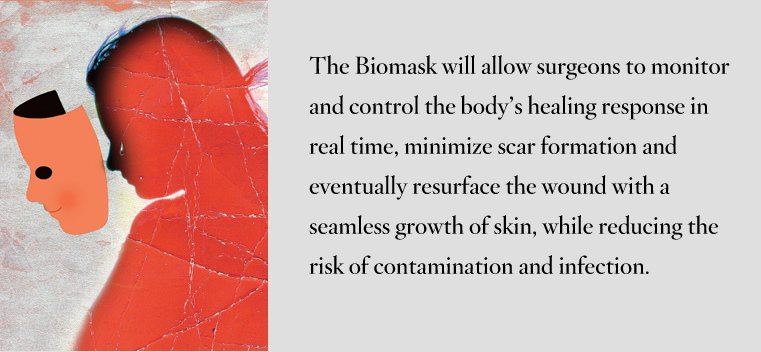
The Face of Hope
Tell us what you think. E-mail comments or questions to the editors at letters@northwestern.edu.
Ever wonder about those strange designations we use throughout Northwestern to identify alumni of the various schools of the University? See the complete list.
Find Us on Social Media
Northwestern researchers collaborate on bioengineered innovation that might help heal wounded warriors.
Improved body armor has saved the lives of thousands of soldiers during the wars in Iraq and Afghanistan, but an increasing number of veterans are coming home with devastating and disfiguring injuries to the parts of the body that are exposed — the hands, legs and face. Unfortunately, patients who are severely injured or burned have few options to replace lost parts of the face without scarring and disfigurement.
“The care for patients with facial burns or severe maxillofacial and craniofacial injuries has evolved over the last 30 years,” plastic surgeon Robert Galiano says, “but the field has reached a plateau.” Skin grafts and flaps leave a patchwork appearance, and although face transplants represent an option for the severest of cases, they require lifelong immunosuppression that carries an increased risk of cancer, as well as the possibility that the body will reject the organ.
Galiano (FSM97), an assistant professor of plastic surgery at the Feinberg School of Medicine, might have a 22nd-century solution to heal these wounded warriors. He’s working with fellow plastic surgery professor Thomas Mustoe and postdoc Claudia Chavez-Munoz, as well as collaborators from the University of Texas at Arlington and the U.S. Army’s Institute of Surgical Research, on a wound-healing Biomask.
The mask will have a rigid shell over a flexible polymer lined with microsensors — to monitor the rate of healing — and fluid delivery systems — to pump antibiotics, painkillers or a stem-cell–infused growth cocktail to the wound. The Biomask will allow surgeons to monitor and control the body’s healing response in real time, minimize scar formation and eventually resurface the wound with a seamless growth of skin, while reducing the risk of contamination and infection.
Galiano and Mustoe have been studying innovative approaches to wound healing for several years. Their research caught the attention of Kai Leung, a researcher at the Institute of Surgical Research in San Antonio, where his colleague Col. Robert Hale is treating injured service members. Hale was putting together a team of researchers to answer the question, “Is there a way we can use tissue engineering to grow a face on a patient?” He approached Mustoe and Galiano to begin a collaborative effort.
Several years ago Galiano and his research colleagues began experimenting with the use of bioreactors and biochambers — systems used to grow cells — that are placed in research animals to grow new tissues. It’s a departure from typical tissue engineering, where researchers try to grow organs in a petri dish.
“There has always been a disconnect in the field of tissue engineering,” Galiano says, “in that very smart investigators have focused their efforts on creating novel matrices in a lab dish and have attempted to add cells that would hopefully behave like skin or muscle or any other tissue type. Unfortunately, it is not possible to create viable tissues in vitro without a blood supply, and even if that were possible, it still is not clear how that tissue would be put back in a patient. Our idea was, let’s engineer a system that would allow us to grow that tissue in the body, since the body already has a preformed vascular network that can support complex tissue growth.”
Galiano, Chavez-Munoz and Mustoe have started pilot experiments to examine how tissues and cells grow in bioreactors they designed to work in animal models. The sensors, to be developed at the University of Texas at Arlington’s Automation & Robotics Research Institute, will be integrated soon. With the help of colleagues Hale and Leung at the Institute of Surgical Research, who are working on separate components of the Biomask, the team hopes to begin clinical trials within five years.
Galiano sees possibilities beyond Biomask, including systems to regrow bone, muscle and even working organs.
“People often ask me, ‘What does a plastic surgeon do?’” Galiano adds. “We’re innovative specialists. The next frontier is to become molecular surgeons and take what we’ve learned about vascular growth, wound healing, and stem cells and start examining how can we manipulate these processes as surgeons. My colleagues and I hope to create a new specialty that is an extension of reconstructive surgery that I call regenerative surgery. We are going to be the tissue engineers of the 22nd century.”



 Facebook
Facebook Twitter
Twitter Email
Email


